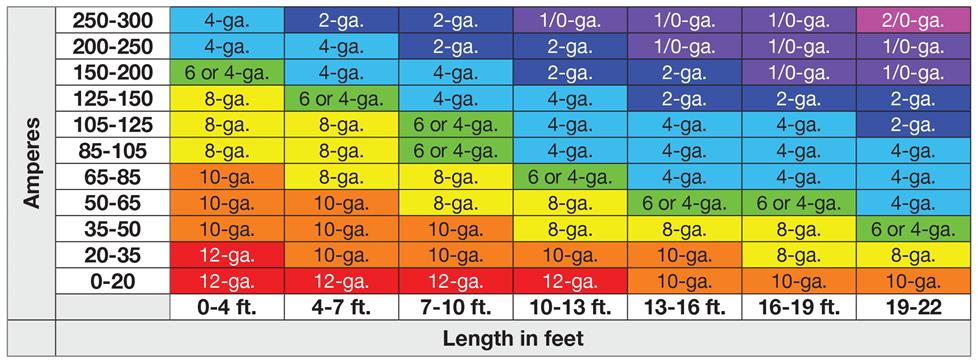Stereo and Speaker is reader-supported. When you buy through links on our site, we may earn an affiliate commission from Amazon at no added cost to you.
If you love music and loves to hear music while traveling, then this piece of writing is something that you must give a read! Installing your audio and music system can be fun and exciting, but sadly, you will have to do some calculations and will have to look at the wire Amp Chart.

Please note that this chart is for stranded copper core wires only. And Copper-clad aluminum (CCA) wires cannot handle the amount of current that a copper wire of the same size can usually do.
If you are someone who doesn’t know how to do it and wants to know about it, then you have just hopped on to the right place. Let’s get going and discover what gauge wire shall you need for the amp.
Let’s get started.
Introduction
Equipped with a straight and straightforward formula, you can be confident that your framework won’t be limited. It shall not get limited because the wires can’t convey the required capacity to your amp. Similarly risky is the point at which the cables are excessively enormous.
And, you have unneeded expenses with bigger wire than you need and the possible overwhelming issue also. That is why you must know how to do the calculations. And, the best part about all this is you can learn with the help of relatively simple steps:
The formula for wire Amp Chart Calculation
If you like music and introducing your sound frameworks in your vehicle, you should do a little math. Outfitted with a basic formula, you can be confident that your framework won’t be limited because the wires can’t convey the required capacity to your amp.
Similarly, risky is when the wires are excessively huge, and you have unneeded expenses with bigger wires than you need and the possible overwhelming issue. Let’s follow the steps given below to know can you make the perfect decision:
Step 1: To start with, you need to decide the currently attractive amperes of your speaker. To do that, you need the all-out force of the framework. And then duplicate the number of channels by the number of watts per channel.
Note: If you have more than one amp, you should include the full force figures to get the last aggregate.
Step 2: When you have the last complete amps, you should two-fold your number and divide it by 13.8.
The number you end up with is the framework’s rough, most extreme current draw with this number and the length of the link you should get from the battery to the sound system.
Step 3: This simple outline can help find the wire expected to have the right force conveyed from the battery to your sound system.
If you get your amperes sorted out effectively by crunching the numbers, we clarified about this ought to be something simple to sort out. Frequently, doing a little math can save you revamping a sound system that isn’t performing effectively. It is also because it has some unacceptable wiring power.
If you have trouble doing the calculations, you can also use this calculator.
Things to Consider For Gauge Wire
Have a look at the things that matters while doing the calculations for your perfect amp:
- Ideal Wire Length
- Wiring of the Speaker
- Wire Gauge
Ideal Wire Length
Wires produce obstruction in them to electrical flow. Thus, this implies that to convey the full voltage to the furthest limit of the wire. The limit of the wire should be that the measure should be huge enough, so the flow when it shows up is usable.
It implies if you need to run the wires a significant distance, you should evaluate the links to be sure that the right voltage shows up at the sound system and speakers.
It implies that you can gag the electrical volts out of your framework with some unacceptable wire. Be sure you know the required volts for the hardware you are running and that your vehicle can give these volts dependent on the electrical framework and the wiring you use.
Wiring of the Speaker
Again, speaker wires should be of an adequate size to convey the sign and force that the speaker needs to work appropriately from the underlying conveyance of energy, right to the speaker that creates the sound. You must tune in to the wire size should be right to work appropriately in the situation.
You need to analyze the length of wire you need and utilize a string to run from the speakers’ intensifier. It will give you an incredibly close thought of how much wire you will use. Make sure to utilize the cables that the speaker calls for, and it’s great. And possibly change if you should. Furthermore, the far superior arrangement is to get speakers that accompany the wires included.
Wire Gauge
Gauge is the estimation to show the thickness of the wires you are utilizing. It implies that the bigger the measure, the thicker the wire. The confounding part is the more significant check gets recorded with a more modest number. The 2-measure wire is a lot thicker for a model when 10, 12, 14, or 18-check wire.
This measure assists with sorting out the capacity. The straightforward graph from the top indeed shows how the number of the action gets greater. However, the wire size gets more modest.
It can be befuddling. Nearly everybody sooner or later gets this pivoted and has returned home with some unacceptable wire size since it recollected that it is the opposite way around.
Along these lines, run the numbers and be sure you know the wire check that you need before you go out and go through that well-deserved money. Nobody likes returning to the home improvement shop again and again!
Ideal Size of the Fuse
Every vehicle sound system, Amplifier, and speaker set will accompany worked in-circuit frameworks. These are production line frameworks, and the wires in the parts should just get supplanted with legitimate breakers. It is to be sure nothing gets harmed for being overwhelmed or even underpowered.
The breaker should have the option to deal with the amps drawn from the principal power supply. If you had two intensifiers and each run at 40 amps, you would utilize an 80-amp combine.
As you have power conveyed from the battery to the whole framework, you have to utilize a breaker to ensure that the framework structure conceivably forces floods. It implies you need to use a breaker under 14.4 volts that the alternator on the vehicle gives.
Getting the correct circuit is again an instance of basic math and exploration. Your proprietor’s manual should list the draw for every one of the segments you have introduced in your vehicle sound framework. If you do the computations and don’t think of a coordinating breaker size, consistently pick the following size greater.
You don’t need the music to remove because the wire blows under typical working conditions. The primary wire should be as near the battery as expected, and that implies they are on the principal wire and near the battery post.
You will need to get a multimeter and check the levels in your framework on the off chance that you are blowing circuits too regularly as there could be a short or another issue. The wire type that you use will rely upon the limit of the current and your own decision.
Be sure that whatever meld you pick, you can get trades for it, as the breaker gets intended to break when it manages its work; you will require substitutions.
Wrapping it up
Wire Amp Chart Calculations can be tricky, but it is not rocket science, but it is not rocket science at all. A little effort can give you the perfect results. Check the information given above and arm yourself with the right information. If you stumble upon any doubt, do let us know in the comment section given below. We will be more than happy to help you out and to present you with the best solution.
If you found this article helpful, make sure to let us know in the comments. And also make sure to check out the best sub amp combos in 2021.
Amazon and the Amazon logo are trademarks of Amazon.com, Inc, or its affiliates.
